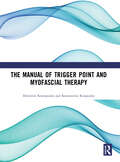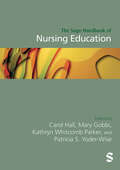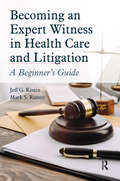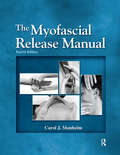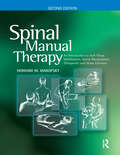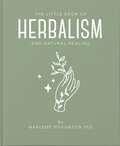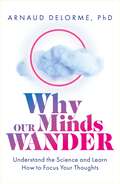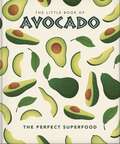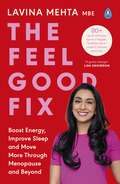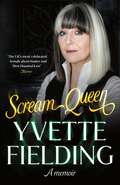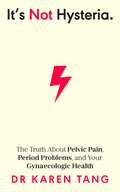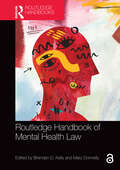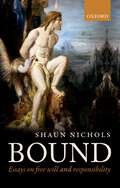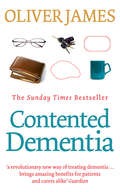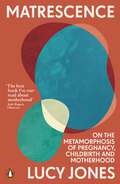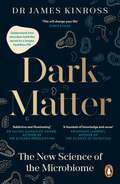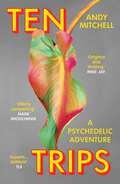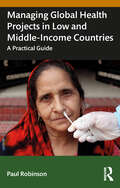- Table View
- List View
The Manual of Trigger Point and Myofascial Therapy
by Dimitrios Kostopoulos Konstantine RizopoulosThe Manual of Trigger Point and Myofascial Therapy offers the reader a comprehensive therapeutic approach for the evaluation and treatment of Myofascial pain and musculoskeletal dysfunction. This user-friendly manual will serve as a quick reference for clinically relevant items that pertain to the identification and management of trigger points.The first section of the book covers the theory and current research regarding the Myofascial Trigger Point Syndrome. The research is the most current and up-to-date available on the pathogenesis of Myofascial dysfunction, clinical symptoms, physical findings as well as diagnostic criteria. Treatment methods and techniques are also covered in a comprehensive and step-by-step format.The second section includes the most important muscles that tend to have a higher incidence of the Myofascial involvement. Each muscle is supplemented by two pages of text and illustrations to better aid the student or clinician in an institutional or practicing setting. The muscle page contains a plethora of information for the reader including muscle origin, insertion, location of trigger points, referenced pain patterns, myofascial stretching exercises, positive stretch signs, and biomechanics of injury. Extensive full-color illustrations and pictures include treatment techniques, therapeutic interventions and patient home exercise programs.This innovative and concise new clinical reference guide is perfect for the student learning about the diagnosis and treatment of the Myofascial Trigger Point Syndrome or therapist interested learning or applying this successful and effective method of treatment.
The Manual of Trigger Point and Myofascial Therapy
by Dimitrios Kostopoulos Konstantine RizopoulosThe Manual of Trigger Point and Myofascial Therapy offers the reader a comprehensive therapeutic approach for the evaluation and treatment of Myofascial pain and musculoskeletal dysfunction. This user-friendly manual will serve as a quick reference for clinically relevant items that pertain to the identification and management of trigger points.The first section of the book covers the theory and current research regarding the Myofascial Trigger Point Syndrome. The research is the most current and up-to-date available on the pathogenesis of Myofascial dysfunction, clinical symptoms, physical findings as well as diagnostic criteria. Treatment methods and techniques are also covered in a comprehensive and step-by-step format.The second section includes the most important muscles that tend to have a higher incidence of the Myofascial involvement. Each muscle is supplemented by two pages of text and illustrations to better aid the student or clinician in an institutional or practicing setting. The muscle page contains a plethora of information for the reader including muscle origin, insertion, location of trigger points, referenced pain patterns, myofascial stretching exercises, positive stretch signs, and biomechanics of injury. Extensive full-color illustrations and pictures include treatment techniques, therapeutic interventions and patient home exercise programs.This innovative and concise new clinical reference guide is perfect for the student learning about the diagnosis and treatment of the Myofascial Trigger Point Syndrome or therapist interested learning or applying this successful and effective method of treatment.
The Sage Handbook of Nursing Education
by Carol Hall Patricia S. Yoder-Wise Mary Gobbi Kathryn Whitcomb ParkerIn the past several years, a revival of research devoted to nursing education has emerged. This emergence has changed the way many educators engage in their practice of working with learners; and learners have come to expect that they will have a rich learning experience designed to develop new (or enhance prior) knowledge, skills, and attitudes. The SAGE Handbook of Nursing Education provides a detailed map of the current discipline, with a carefully selected team of international contributors offering the latest thinking about education in nursing across key areas. This handbook will be a key resource for academic educators, as well as graduate and postgraduate learners.
The Sage Handbook of Nursing Education
by Carol Hall Patricia S. Yoder-Wise Mary Gobbi Kathryn Whitcomb ParkerIn the past several years, a revival of research devoted to nursing education has emerged. This emergence has changed the way many educators engage in their practice of working with learners; and learners have come to expect that they will have a rich learning experience designed to develop new (or enhance prior) knowledge, skills, and attitudes. The SAGE Handbook of Nursing Education provides a detailed map of the current discipline, with a carefully selected team of international contributors offering the latest thinking about education in nursing across key areas. This handbook will be a key resource for academic educators, as well as graduate and postgraduate learners.
Becoming an Expert Witness in Health Care and Litigation: A Beginner's Guide
by Mark Ramey Jeff G. KoninA resource for health care professionals in beginning, improving, or successfully marketing a career as an expert witness, Becoming an Expert Witness in Health Care and Litigation: A Beginner’s Guide provides fundamental information on the legal process and practical advice for readers across various fields of medicine and allied health.The book draws on the authors’ experiences as both expert witnesses and litigation experts who have trained hundreds of nurses, physicians, and health care professionals. Covering topics like the fundamentals of litigation and the legal process and trial preparation, Becoming an Expert Witness in Health Care and Litigation explores the basic principles of being an expert witness while offering practical advice that will enable expert witnesses and attorneys to maximize their effectiveness.Topics covered include: Roles and expectations of key players Courtroom presentation Depositions and trials Moral issues Writing for the court Business of expert witnessing Ethical marketing Also included in Becoming an Expert Witness in Health Care and Litigation: Checklists Example expert witness forms like fee structures, engagement letters, and more A comprehensive glossary of industry terms Those looking to break into the field and seasoned expert witnesses alike will find that Becoming an Expert Witness in Health Care and Litigation: A Beginner’s Guide offers valuable insights and guidance.
The Myofascial Release Manual
by Carol ManheimContinuing the tradition that started over 20 years ago and with a new focus on the current terminology regarding each technique, The Myofascial Release Manual is now available in a completely updated and comprehensive Fourth Edition.Carol J. Manheim has taken years of knowledge and expertise and incorporated them with the actual intent and result of the myofascial release treatment techniques to bring to the pages of this Fourth Edition essential information for the student and clinician in search of basic information or wanting to refine more experienced skills of these manual therapy techniques. Features inside the Fourth Edition: -Techniques re-titled to reflect the sensation felt by both the therapist and the patient -More than 75 new photographs—Over 450 in total -Some photographs are shown as a series to allow for movement to be seen during some techniques -Bolded text to call attention to major warnings, contraindications, and target vital information -Italicized text to call attention to important words and key points -More synthesized use of text and photographs to allow for ease of reading and reference -User-friendly organization throughout the text -Photographs use arrows to show direction of stretch and movement -“Carol’s Nuggets” of pearls of wisdom are included throughout the text -Contributions from renowned experts Sam Kegerreis, Robert O. Ward, and Steven Nowicki The Myofascial Release Manual, Fourth Edition continues in the tradition of past editions and presents expert hand placement for the upper quarter, lower quarter, cervical region, abdominal muscles, back muscles, and many more. Sections include: -Introduction to Myofascial Release -Basic Myofascial Release Techniques -Advanced Myofascial Release Techniques -Evaluation -Additional Resources The description and photographs in The Myofascial Release Manual, Fourth Edition help the therapist experience the technique, making this the continued go-to reference for students and clinicians in physical therapy, manual therapy, and occupational therapy alike.
The Myofascial Release Manual
by Carol ManheimContinuing the tradition that started over 20 years ago and with a new focus on the current terminology regarding each technique, The Myofascial Release Manual is now available in a completely updated and comprehensive Fourth Edition.Carol J. Manheim has taken years of knowledge and expertise and incorporated them with the actual intent and result of the myofascial release treatment techniques to bring to the pages of this Fourth Edition essential information for the student and clinician in search of basic information or wanting to refine more experienced skills of these manual therapy techniques. Features inside the Fourth Edition: -Techniques re-titled to reflect the sensation felt by both the therapist and the patient -More than 75 new photographs—Over 450 in total -Some photographs are shown as a series to allow for movement to be seen during some techniques -Bolded text to call attention to major warnings, contraindications, and target vital information -Italicized text to call attention to important words and key points -More synthesized use of text and photographs to allow for ease of reading and reference -User-friendly organization throughout the text -Photographs use arrows to show direction of stretch and movement -“Carol’s Nuggets” of pearls of wisdom are included throughout the text -Contributions from renowned experts Sam Kegerreis, Robert O. Ward, and Steven Nowicki The Myofascial Release Manual, Fourth Edition continues in the tradition of past editions and presents expert hand placement for the upper quarter, lower quarter, cervical region, abdominal muscles, back muscles, and many more. Sections include: -Introduction to Myofascial Release -Basic Myofascial Release Techniques -Advanced Myofascial Release Techniques -Evaluation -Additional Resources The description and photographs in The Myofascial Release Manual, Fourth Edition help the therapist experience the technique, making this the continued go-to reference for students and clinicians in physical therapy, manual therapy, and occupational therapy alike.
Spinal Manual Therapy: An Introduction to Soft Tissue Mobilization, Spinal Manipulation, Therapeutic and Home Exercises
by Howard W. MakofskySpinal Manual Therapy: An Introduction to Soft Tissue Mobilization, Spinal Manipulation, Therapeutic and Home Exercises, Second Edition is an easy-to-follow manual of clinical techniques for the spine, pelvis, and temporomandibular joint. The text provides "tools" rather than "recipes" and immerses the reader in the process of "thinking as a manual therapist", rather than functioning as a technician. The clinical utility of this revised second edition combines the art and science of present day spinal manual therapy.The focus of Spinal Manual Therapy, Second Edition is to provide clinically useful treatment techniques, while being mindful of the scientific literature related to the practice of spinal manual therapy. It is an ideal resource for all those interested in grasping the basics of spinal manual therapy and transferring that knowledge into practice within a clinical environment.The hands-on approach taken by Dr. Howard W. Makofsky makes this new edition the go-to textbook for spinal manual therapy.New to the Second Edition: New pictures of examination and treatment techniques with captions Additional case studies New evidence supporting spinal manual therapy Updated references throughout the text This unique textbook has a plethora of clinical techniques, including the rationale for each of their use. With over 300 figures, illustrations, and photographs for each examination/treatment technique for various regions of the body, students and clinicians learning manual therapy will benefit greatly from Spinal Manual Therapy, Second Edition.Inside you’ll find: Evaluation Soft tissue techniques Manipulative procedures Specific exercises Clinical problem solving Spinal Manual Therapy, Second Edition mirrors a course on the introduction to spinal manual therapy and will be welcomed into physical therapy curriculums, as well as appreciated by clinicians when entering clinical practice.
Spinal Manual Therapy: An Introduction to Soft Tissue Mobilization, Spinal Manipulation, Therapeutic and Home Exercises
by Howard W. MakofskySpinal Manual Therapy: An Introduction to Soft Tissue Mobilization, Spinal Manipulation, Therapeutic and Home Exercises, Second Edition is an easy-to-follow manual of clinical techniques for the spine, pelvis, and temporomandibular joint. The text provides "tools" rather than "recipes" and immerses the reader in the process of "thinking as a manual therapist", rather than functioning as a technician. The clinical utility of this revised second edition combines the art and science of present day spinal manual therapy.The focus of Spinal Manual Therapy, Second Edition is to provide clinically useful treatment techniques, while being mindful of the scientific literature related to the practice of spinal manual therapy. It is an ideal resource for all those interested in grasping the basics of spinal manual therapy and transferring that knowledge into practice within a clinical environment.The hands-on approach taken by Dr. Howard W. Makofsky makes this new edition the go-to textbook for spinal manual therapy.New to the Second Edition: New pictures of examination and treatment techniques with captions Additional case studies New evidence supporting spinal manual therapy Updated references throughout the text This unique textbook has a plethora of clinical techniques, including the rationale for each of their use. With over 300 figures, illustrations, and photographs for each examination/treatment technique for various regions of the body, students and clinicians learning manual therapy will benefit greatly from Spinal Manual Therapy, Second Edition.Inside you’ll find: Evaluation Soft tissue techniques Manipulative procedures Specific exercises Clinical problem solving Spinal Manual Therapy, Second Edition mirrors a course on the introduction to spinal manual therapy and will be welcomed into physical therapy curriculums, as well as appreciated by clinicians when entering clinical practice.
Becoming an Expert Witness in Health Care and Litigation: A Beginner's Guide
by Mark Ramey Jeff G. KoninA resource for health care professionals in beginning, improving, or successfully marketing a career as an expert witness, Becoming an Expert Witness in Health Care and Litigation: A Beginner’s Guide provides fundamental information on the legal process and practical advice for readers across various fields of medicine and allied health.The book draws on the authors’ experiences as both expert witnesses and litigation experts who have trained hundreds of nurses, physicians, and health care professionals. Covering topics like the fundamentals of litigation and the legal process and trial preparation, Becoming an Expert Witness in Health Care and Litigation explores the basic principles of being an expert witness while offering practical advice that will enable expert witnesses and attorneys to maximize their effectiveness.Topics covered include: Roles and expectations of key players Courtroom presentation Depositions and trials Moral issues Writing for the court Business of expert witnessing Ethical marketing Also included in Becoming an Expert Witness in Health Care and Litigation: Checklists Example expert witness forms like fee structures, engagement letters, and more A comprehensive glossary of industry terms Those looking to break into the field and seasoned expert witnesses alike will find that Becoming an Expert Witness in Health Care and Litigation: A Beginner’s Guide offers valuable insights and guidance.
The Little Book of Herbalism and Natural Healing (The\little Book Of... Ser.)
by Marlene HoughtonAn introduction to everything you need to enhance your life using nature's pharmacy.This tiny guide will teach you everything you need to know about herbalism, the therapeutic use of plants as medicine for holistic healing, also known as Phytotherapy. The Little Book of Herbalism and Natural Healing demonstrates how herbs can be used to strengthen the body's functions and enable it to heal itself, often without resorting to antibiotics. Whether you want to learn how to use herbs for common everyday ailments or how to grow your own herbs and use them in cooking, this trusty tome is the perfect companion.Herbal Immunity In Nature's Pharmacy there are herbs that act as protectors and immune boosters.Elderberry This rich, dark purple berry has been used for hundreds of years in Europe. It has proven health-supporting properties. Full of flavonoids – an important group of plant substances – due to elderberry's anti-viral action, this flu-fighter is good to take during the winter season as a preventative.
Why Our Minds Wander: Understand the Science and Learn How to Focus Your Thoughts
by Arnaud DelormeWe all daydream; we've all experienced that moment when we suddenly realise that instead of paying attention in a meeting or reading a book, our mind has wandered. In that moment our conscious mind has detached from the current task at hand and drifted elsewhere.Our attention is a powerful lens which allows us to pick out and filter relevant details from the vast amounts of information our brains receive – so how does our brain decide where to go when it wanders, why does it focus on one thing over another? How important is daydreaming and why do we do it?Traditionally daydreaming was considered to be a single state of mind. However, recent research has shown that not only are there different states of daydreaming, these states are actually governed by different neurological pathways, meaning not all mind wandering is the same!Here, Arnaud Delorme PhD examines the science and theory behind why we daydream, examining its potential purpose. He shows you how to tame your 'monkey mind' and offers easy techniques that will enable you to develop the skill of mind wandering to improve your mood and foster greater creativity.
The Little Book of Avocado: The ultimate superfood (The\little Book Of... Ser.)
by Orange Hippo!Quotes, facts, wit & wisdom in a fun-filled format
The Feel Good Fix: Boost Energy, Improve Sleep and Move More Through Menopause and Beyond
by Lavina Mehta MBEThe Feel Good Fix is specifically designed to improve your health in perimenopause, menopause and beyond, offering quick, fun and effective bitesize exercise, as well as mind and lifestyle ‘snacks’ to make you feel good, both physically and mentally.Balancing work, home, life and family pressures, alongside the host of symptoms you might experience in menopause, can be overwhelming, so personal trainer Lavina Mehta’s advice in this book is anything but. Lavina uses the latest research and her Feel Good toolkit can have a powerful effect on your energy levels, mood and fitness in only eleven minutes a day. Exercise snacks (not food, but a short period of activity) can easily be integrated into our busy routines, but still have the power to create a significant impact on our health by helping you to move more, discover calm and live well.No equipment, no special clothes, no experience needed. Just a few minutes to spare and the willingness to pick ’n’ mix a few squats, time in nature, selfcare or breath snacks into your day to get your daily fix!
Scream Queen: A memoir
by Yvette FieldingSeances, Ouija boards, table tipping, knocking phenomena - all in a day's work for the First Lady of the Paranormal. Yvette Fielding has nerves of steel when facing down her tormentors in the spirit world. Her living-world personal story also reveals a woman of courage and determination, who built success from nothing, following her passion and lifelong curiosity in search of answers to the unexplained.Yvette was always fascinated with the afterlife, and Buddhist meditation practice opened her up to any spirit who wanted to contact her. This manifested in her first family home. Their TV would switch itself on, and kitchen cupboards would open and close all by themselves. When alone there, Yvette would arm herself with a Samurai sword to confront her unseen visitors.But it was a harrowing investigation of eerie 800 year-old Michelham Priory where Yvette’s life-changing Most Haunted adventure began, and still continues many terrifying quests and over twenty years later.Here you’ll walk with Yvette where others fear to tread through chills of the supernatural kind, and she also talks with candid honesty of occasional cold spots she’s encountered in human form. But through all the drops in temperature, the nation’s most celebrated ghost hunter radiates warmth and humour and it’s a joy to accompany her on her incredible journey from child TV star to Most Haunted icon.Beware sceptics: the Scream Queen's story could change your world view for ever.
It’s Not Hysteria: The Truth About Pelvic Pain, Period Problems, and Your Gynaecologic Health
by Dr Karen TangDid you know that up to 90% of women experience menstrual abnormalities or pelvic problems in their lifetime? Yet these issues are overwhelmingly misunderstood, misdiagnosed, or dismissed. Conditions such as PCOS, endometriosis, fibroids, ovarian cysts, PMDD, or pelvic floor dysfunction, don’t receive the stream of funding for research and new treatments that other conditions do, despite affecting up to half the population.It's Not Hysteria shares critical knowledge that anyone impacted by these conditions desperately needs. Covering everything from the anatomy and reproductive health basics you wish you learned at school, to issues such as abnormal periods, PCOS, endometriosis, and fibroids, to more complex aspects of gynaecologic care like fertility, sexual health, and hysterectomies. Dr Tang's accessible advice empowers readers to take action and advocate for themselves with healthcare professionals.At a turbulent time when global health, reproductive, and human rights are under siege, Dr Tang is determined to revolutionise how gynaecologic health and pelvic pain are treated by the medical community. This book will be part of the fight for the healthcare all people with uteruses deserve - healthcare that is intersectional, gender-affirming, validating and hopeful.
Routledge Handbook of Mental Health Law (Routledge Handbooks in Law)
by Brendan D. Kelly and Mary DonnellyMental health law is a rapidly evolving area of practice and research, with growing global dimensions. This work reflects the increasing importance of this field, critically discussing key issues of controversy and debate, and providing up-to-date analysis of cutting-edge developments in Africa, Asia, Europe, the Americas, and Australia.This is a timely moment for this book to appear. The United Nations’ Convention on the Rights of Persons with Disabilities (2006) sought to transform the landscape in which mental health law is developed and implemented. This Convention, along with other developments, has, to varying degrees, informed sweeping legislative reforms in many countries around the world. These and other developments are discussed here. Contributors come from a wide range of countries and a variety of academic backgrounds including ethics, law, philosophy, psychiatry, and psychology. Some contributions are also informed by lived experience, whether in person or as family members. The result is a rich, polyphonic, and sometimes discordant account of what mental health law is and what it might be.The Handbook is aimed at mental health scholars and practitioners as well as students of law, human rights, disability studies, and psychiatry, and campaigners and law- and policy-makers.
Bound: Essays on free will and responsibility
by Shaun NicholsThe problem of free will arises from ordinary, commonsense reflection. Shaun Nichols examines these ordinary attitudes from a naturalistic perspective. He offers a psychological account of the origins of the problem of free will. According to his account the problem arises because of two naturally emerging ways of thinking about ourselves and the world, one of which makes determinism plausible while the other makes determinism implausible. Although contemporary cognitive science does not settle whether choices are determined, Nichols argues that our belief in indeterminist choice is grounded in faulty inference and should be regarded as unjustified. However, even if our belief in indeterminist choice is false, it's a further substantive question whether that means that free will doesn't exist. Nichols argues that, because of the flexibility of reference, there is no single answer to whether free will exists. In some contexts, it will be true to say 'free will exists'; in other contexts, it will be false to say that. With this substantive background in place, Bound promotes a pragmatic approach to prescriptive issues. In some contexts, the prevailing practical considerations suggest that we should deny the existence of free will and moral responsibility; in other contexts the practical considerations suggest that we should affirm free will and moral responsibility. This allows for the possibility that in some contexts, it is morally apt to exact retributive punishment; in other contexts, it can be apt to take up the exonerating attitude of hard incompatibilism.
Bound: Essays on free will and responsibility
by Shaun NicholsThe problem of free will arises from ordinary, commonsense reflection. Shaun Nichols examines these ordinary attitudes from a naturalistic perspective. He offers a psychological account of the origins of the problem of free will. According to his account the problem arises because of two naturally emerging ways of thinking about ourselves and the world, one of which makes determinism plausible while the other makes determinism implausible. Although contemporary cognitive science does not settle whether choices are determined, Nichols argues that our belief in indeterminist choice is grounded in faulty inference and should be regarded as unjustified. However, even if our belief in indeterminist choice is false, it's a further substantive question whether that means that free will doesn't exist. Nichols argues that, because of the flexibility of reference, there is no single answer to whether free will exists. In some contexts, it will be true to say 'free will exists'; in other contexts, it will be false to say that. With this substantive background in place, Bound promotes a pragmatic approach to prescriptive issues. In some contexts, the prevailing practical considerations suggest that we should deny the existence of free will and moral responsibility; in other contexts the practical considerations suggest that we should affirm free will and moral responsibility. This allows for the possibility that in some contexts, it is morally apt to exact retributive punishment; in other contexts, it can be apt to take up the exonerating attitude of hard incompatibilism.
Contented Dementia: 24-hour Wraparound Care for Lifelong Well-being
by Oliver JamesDementia is a little understood and currently incurable illness, but much can be done to maximise the quality of life for people with the condition. Contented Dementia - by clinical psychologist and bestselling author Oliver James - outlines a groundbreaking and practical method for managing dementia that will allow both sufferer and carer to maintain the highest possible quality of life, throughout every stage of the illness.A person with dementia will experience random and increasingly frequent memory blanks relating to recent events. Feelings, however, remain intact, as do memories of past events and both can be used in a special way to substitute for more recent information that has been lost. The SPECAL method (Specialized Early Care for Alzheimer's) outlined in this book works by creating links between past memories and the routine activities of daily life in the present. Drawing on real-life examples and user-friendly tried-and-tested methods, Contented Dementia provides essential information and guidance for carers, relatives and professionals.
Matrescence: On the Metamorphosis of Pregnancy, Childbirth and Motherhood
by Lucy Jones*A New Statesman and Daily Mail BOOK OF THE YEAR**Longlisted for the 2024 Women's Prize for Non-Fiction*'The best book I've ever read about motherhood' Jude Rogers, Observer'I kept scribbling in the margins: 'We need to know this stuff!'' Joanna Pocock, SpectatorA radical new examination of the transition into motherhood and how it affects the mind, brain and bodyDuring pregnancy, childbirth, and early motherhood, women undergo a far-reaching physiological, psychological and social metamorphosis.There is no other time in a human's life course that entails such dramatic change-other than adolescence. And yet this life-altering transition has been sorely neglected by science, medicine and philosophy. Its seismic effects go largely unrepresented across literature and the arts. Speaking about motherhood as anything other than a pastel-hued dream remains, for the most part, taboo.In this ground-breaking, deeply personal investigation, acclaimed journalist and author Lucy Jones brings to light the emerging concept of 'matrescence'. Drawing on new research across various fields - neuroscience and evolutionary biology; psychoanalysis and existential therapy; sociology, economics and ecology - Jones shows how the changes in the maternal mind, brain and body are far more profound, wild and enduring than we have been led to believe. She reveals the dangerous consequences of our neglect of the maternal experience and interrogates the patriarchal and capitalist systems that have created the untenable situation mothers face today.Here is an urgent examination of the modern institution of motherhood, which seeks to unshackle all parents from oppressive social norms. As it deepens our understanding of matrescence, it raises vital questions about motherhood and femininity; interdependence and individual identity; as well as about our relationships with each other and the living world.
Dark Matter: The New Science of the Microbiome
by James Kinross‘Will change your life’ Chris Evans‘Completely fascinating’ Heston Blumenthal‘Important and devastating’ The TimesFrom a world-leading microbiome scientist and surgeon comes Dark Matter, a pioneering guide to hacking your microbiome for a healthier life.Our microbiome – the complex ecosystem of bacteria, viruses and other microbes inside us – is vital for our health and wellbeing. An invisible powerhouse whose potential we’re only just beginning to understand, it influences our mood and appetite, determines how fast we run and even who we choose as a partner.In this ground-breaking book, microbiome expert Dr James Kinross takes us on a guided tour of our extraordinary inner universe and highlights the damage we inflict when we don’t protect it. Showing through cutting-edge research and years of clinical experience, the practical steps we can all take to optimise the microbiome to live better, healthier lives.Now with a new, eye-opening afterword on the rise of home microbiome tests, IBS and FMTs. ‘Addictive and illuminating’ Dr Saliha Mahmood Ahmed, bestselling author of The Kitchen Prescription
Ten Trips: The New Reality of Psychedelics
by Andy Mitchell‘An original and thrilling investigation into psychedelics and the claims that currently surround them, achieving profound insights into their essential qualities’ Mike Jay, author of Psychonauts Psychedelics have made a comeback, but the truth is they remain a mystery.In this daring, profound and wildly entertaining investigation, clinical neuropsychologist Andy Mitchell tests the claims being made for these substances by taking ten different psychedelics in ten different settings.Journeying from a neuroimaging lab in London to the Colombian Amazon via Silicon Valley and his friend’s basement kitchen, his encounters with scientists and gangsters, venture capitalists and con men, psychonauts and shamans, and above all with the drugs themselves, take us beyond the hype and reveal the reality of psychedelics – that they are as enchanting but ultimately unfathomable as experience itself.‘Utterly compelling. Some books are in a category of their own and this is one them. Reading it is like having an out of body experience’ Mark Miodownik, author of Stuff Matters'An incisive, deeply personal and beautifully written account of the power, the uses and the modern misuses of psychedelics. Highly recommended' Anil Seth, author of Being You‘Wonderful . . . a journey into the nature and potential of consciousness itself’ Literary Review‘Superb . . . brilliant’ TLS
Managing Global Health Projects in Low and Middle-Income Countries: A Practical Guide
by Paul RobinsonWith over 30 years of experience in global health programming and teaching, the author offers practical and insightful guidance in this unique book for managing global health projects in resource-constrained settings.Beginning with an overview of fundamental principles, the book delves deeply into a ‘nuts and bolts’ approach to health project management. From building project teams and developing detailed activity plans to evaluating health projects and report writing, this book brings the readers a wealth of knowledge they can use to manage health projects. Besides a list of key takeaways and discussion questions, each chapter features a case study exercise from real life situation where readers can picture themselves as project managers, sharpening their understanding of concepts and strategies.Timely and original, this book is an essential resource for university students of global health courses preparing to manage global health projects in low- and middle-income countries, as well as for newly engaged project managers.
Managing Global Health Projects in Low and Middle-Income Countries: A Practical Guide
by Paul RobinsonWith over 30 years of experience in global health programming and teaching, the author offers practical and insightful guidance in this unique book for managing global health projects in resource-constrained settings.Beginning with an overview of fundamental principles, the book delves deeply into a ‘nuts and bolts’ approach to health project management. From building project teams and developing detailed activity plans to evaluating health projects and report writing, this book brings the readers a wealth of knowledge they can use to manage health projects. Besides a list of key takeaways and discussion questions, each chapter features a case study exercise from real life situation where readers can picture themselves as project managers, sharpening their understanding of concepts and strategies.Timely and original, this book is an essential resource for university students of global health courses preparing to manage global health projects in low- and middle-income countries, as well as for newly engaged project managers.
